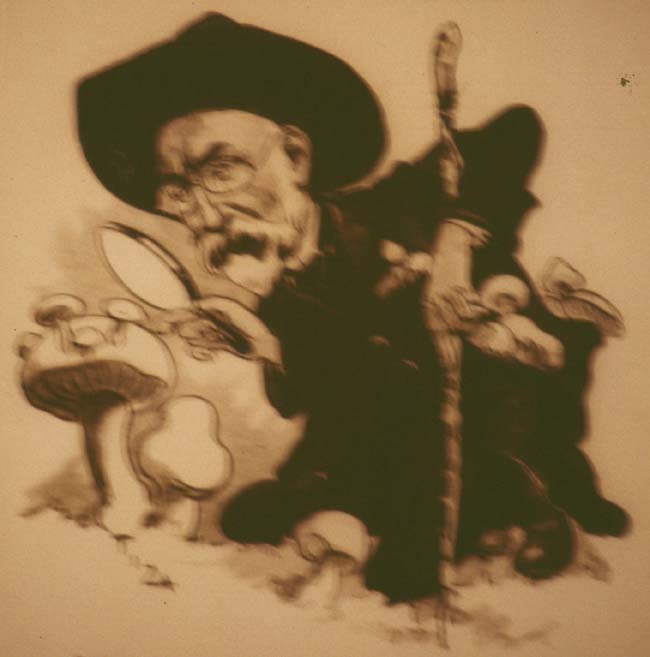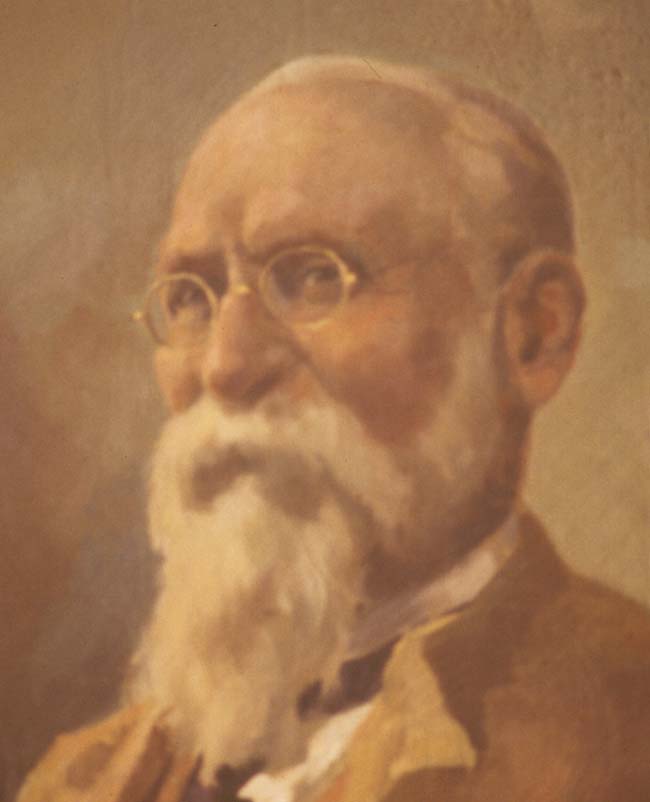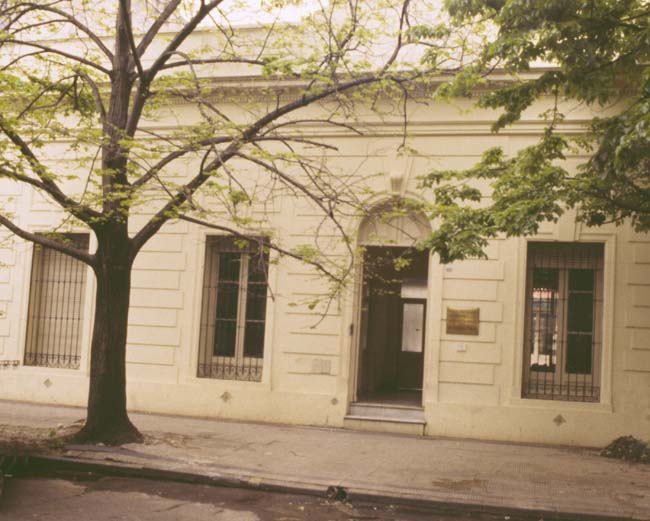Arrival in Argentina. In 1879 Spegazzini decided to travel to South America, and so set off that same year for Brazil. An epidemic of yellow fever prevented him from landing, and he decided to continue his journey to Buenos Aires, where he appears to have taken up the temporary post of assistant (acting professor) to the chair of botany at the Faculty of Natural Sciences. A year later, he began the first of many major works, Fungi Argentini, in which he described 827 fungal taxa, many of them new, completing this publication in 1882, at which time he was still resident in Italy.
 An exciting expedition. During the summer of 1881-2, Spegazzini visited Patagonia and Tierra del Fuego as a member of Lieutenant Bové's expedition on the ill-fated schooner Golden West. The expedition called in at the early mission settlement in Ushuaia, staying with the Bridges family. In his autobiography, Uttermost Part of the Earth, Lucas Bridges, the missionary's son, recalls that "Signor Spegazzini, a botanist, with his magnificent beard and vast paraphernalia, made a great impression on us youngsters", and provides a graphic account of the subsequent loss of the Golden West. In spite of the shipwreck, and other difficulties, Spegazzini was able to collect 461 species of fungi on this trip, which provided him with his first real experience of the natural history of South America. The Latin introduction to his subsequent publication Fungi Fuegiani contains an elegant and understated reference to the shipwreck and an apology that the fungi collected were less numerous as a result.
An exciting expedition. During the summer of 1881-2, Spegazzini visited Patagonia and Tierra del Fuego as a member of Lieutenant Bové's expedition on the ill-fated schooner Golden West. The expedition called in at the early mission settlement in Ushuaia, staying with the Bridges family. In his autobiography, Uttermost Part of the Earth, Lucas Bridges, the missionary's son, recalls that "Signor Spegazzini, a botanist, with his magnificent beard and vast paraphernalia, made a great impression on us youngsters", and provides a graphic account of the subsequent loss of the Golden West. In spite of the shipwreck, and other difficulties, Spegazzini was able to collect 461 species of fungi on this trip, which provided him with his first real experience of the natural history of South America. The Latin introduction to his subsequent publication Fungi Fuegiani contains an elegant and understated reference to the shipwreck and an apology that the fungi collected were less numerous as a result.
His subsequent career. In 1884, after his return from this expedition, Spegazzini took up permanent residence in La Plata, and the position of Assistant Professor of Botany at the Faculty in Buenos Aires. He also founded and taught in a provincial college, and was a professor at the School for Agriculture and Cattle Breeding in Santa Catalina. He later became a fellow of the provincial college after the formation of the Faculty for Agronomy and Veterinary Medicine there. From November 1883 to May 1885, he produced another new and major work, Fungi Guaranitici. In 1887 Spegazzini became a Professor of Zoology at the University of La Plata. From 1897 to 1912 he was Director of the Provincial University; he later became an honorary member and Dean. He became Professor of Botany and Phytopathology, and was in charge of the Botanical Section of the Museo de La Plata. From November 1897 to the January of the next year, he produced Fungi Argentini Novi, a monumental work in 17 parts, detailing 1882 taxa, most of which were new. In 1912 Spegazzini became Director of the Ministry of Agriculture, and was thus able to become a private scientist, and devote more time to his extensive herbarium.
 Old age. There is a charming account by the United States mycologist W.A. Murrill of a visit he made in 1924 to Spegazzini when this great mycologist was already an old man.
Old age. There is a charming account by the United States mycologist W.A. Murrill of a visit he made in 1924 to Spegazzini when this great mycologist was already an old man.
"Yesterday I spent the day with Dr Carlos Spegazzini in his house in La Plata. He lives at No 477, Calle 53, in a fine section of the town not far from the principal places of interest and within a short distance of the railway station. His house is immense, with a large patio, or central court, filled with plants and birds. A small green parakeet is a great pet and makes a lot of noise unless it is continually fondled. It loves especially to sit on Dr Spegazzini's shoulder and comb out his whiskers with its curved beak. On the left as one enters is the Doctor's study, but he seems to have books and specimens everywhere and we went from one room to another to examine them, keeping the four daughters and the Indian servant girl dodging about to keep out of our way.
"Dr Spegazzini is an old man, but strong in body, young in thought, and still full of the spirit of adventure. He has just returned from Tierra del Fuego, is planning to go to Europe next year, and promises me to come to the United States the following year 'if nothing happens'. He was born in a village in Italy and was a student of the fungi there before coming to Argentina. He has described a great many South American plants in various groups but his work is poorly known elsewhere and few of his specimens have been seen by other botanists. Like our Dr Peck, he has been a pioneer in many fields and has had to make his way practically alone, although I find that some of his fungi have been sent to Bresadola, the great mycologist of Trent, in Italy. Like John Torrey, his work has been in Chemistry and his play in Botany, Anthropology, etc. The great Linnaeus was a physician and many preachers, like Berkeley, Curtis, and Schweinitz, have been mycologists. It is good to have a hobby that will take one out into the woods and fields.
"The Doctor is exceedingly genial in manner and very kind hearted. He and his son stayed with me all day long, showing me specimens, photographs and publications; giving me anything I wanted for our herbarium; taking me out to a sportsman's club for lunch; visiting the museum; and going on a short collecting trip in the woods. We talked French, German, English, Latin and Spanish indiscriminately and recklessly, keeping up a continuous flow of conversation lest our ignorance in certain languages be discovered. When we returned from a very hot walk, for the day was unusually warm, one of the daughters had made some excellent ice-cream, which we ate greedily.
"Seeing the great Natural History Museum at La Plata under Dr Spegazzini's special care was a privilege and pleasure I shall never forget. The remains of extinct animals, the various races of men, the birds and snakes and insects, with many other things of greatest interest to a naturalist were beautifully displayed and represented by countless specimens. I saw the handsome butterflies for which South America has long been famous and the birds so delightfully described by Hudson. There was a whole case full of the green beetles used in jewellery and Dr Spegazzini pointed out to me the longicorn beetle that is fast killing the large eucalyptus trees (Eucalyptus amygdalina) near the museum. This borer was introduced from Australia with the trees and nothing can be done to stop its ravages.
"In an oak grove nearby, where the wild doves were softly cooing, we found our common polypore, Hapalopilus gilvus, abundant on decayed white oaks; while beside a lake a little farther on we saw many white poplar trees (Populus alba) bent over from the attacks of another polypore, Trametes gallica, which feeds especially on living poplars and willows. At the main entrance to the museum building, near some beautiful young trees of the clammy locust (Robinia viscosa) with rose-coloured flowers, Dr Spegazzini stopped and sadly pointed to a Ficus tree planted as a memorial to his two older sons killed in the late war in Europe.
"I had remarked that Paraguay tea was as yet an untasted beverage so far as I was concerned; so, before leaving La Plata, the Indian girl brought me some in a cup made of horn with a tube of silver through which it is sipped. Then I came away with a large box of specimens, several books, and many pleasant memories. One of these books, which lies before me now on the table, is a thick volume devoted to the Acacia trees and shrubs of Argentina, well illustrated with photographs and drawings, for Dr Spegazzini, in addition to all his other accomplishments, is an excellent photographer and artist."
Spegazzini died on 1st July, 1926, in La Plata. Over 45 years, he produced an enormous number of studies on Argentine fungi, moving in a practically unexplored field and describing one new taxon after another. Altogether he published about 150 papers, not only on fungi but on flowering plants as well, and was awarded the degree of Doctor of Science. In his will, Spegazzini generously donated his family house to the museum of La Plata, with the condition that it should be transformed into an institute bearing his name. His bequest further included all his collections, books and scientific instruments. The Instituto Spegazzini, which is still located in his house, and which is one of the institutions collaborating in the current website, was founded on 26th April 1930.
|
Bibliography
|
 |
||||||||||||
| Top of file
Previous page Home page |